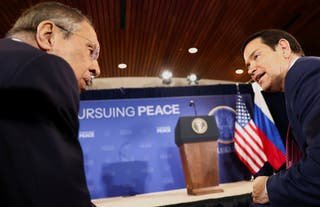Hamas gunmen entered an IDF post near Khan Yunis from a tunnel 40 to 50 meters away, with cameras disabled and no lookouts on that side, wounding three soldiers before 15 attackers were killed.
On Wednesday, Hamas fighters penetrated an IDF military defensive position around Khan Yunis.
Although in the end, only three IDF soldiers were wounded and 15 Hamas terrorists were killed, and the military regained control of the position relatively rapidly, the very fact of Hamas penetrating deep into the position 22 months after the IDF thought it had learned the lessons of being overconfident on defense on October 7, 2023, has shaken the defense establishment.
How did Hamas pull it off?
The first piece is the tunnel from which the Hamas forces surprised the IDF.
It was only 40-50 meters from the position, which the IDF said left them essentially no response time to block them from penetrating the position.

Israeli soldiers walk out from a tunnel underneath the European Hospital in Khan Yunis in the Gaza Strip, June 8, 2025. (credit: REUTERS/Ronen Zvulun)
This answer raises several additional questions.
How could it be 22 months into the war and with so much of Gaza destroyed by the IDF that they missed a tunnel so close to the position?
Here, some modesty is required.
IDF targeting of Hamas’s tunnel system
While the first few months of the war and even the first year or so of the war saw IDF and political echelon declarations of having destroyed 80% of the tunnels in one area or another, over time it became clear that these statements were either disconnected from reality or skipped over an important nuance.
Nearly all of Hamas’ “strategic tunnels” (tunnels for moving large objects and supplies between different regions of Gaza, as well as for hiding communications, intelligence, and weapons development bases) were destroyed in 2024 (though one more large one was found in April of this year).
However, no one knows how many small “tactical tunnels” (simply for the movement of small numbers of Hamas forces within a localized area) there are or were, and only a few months ago, a guess was given that the IDF had possibly only destroyed 25% of these.
Next, the IDF only took over 75% of Gaza territory since the May-July period.
So, really, the war over 75% of small tunnels in 75% of Gaza only started in the last couple of months.
That means that if anything, the IDF should expect that Hamas has small tunnels near most of its new forward Gaza positions.
Incidentally, the IDF said that around two months before, there had been inspections of the area and portions of tunnels related to the attack tunnel used by Hamas had been dealt with, but apparently not completely, or the particular portion of the network of tunnels had not been dealt with.
Still, why didn’t soldiers standing at the top of the position and its trenches fire on the approaching Hamas invaders during the 40-50 meter run?
Maybe some of the Hamas invaders still would have gotten in, but maybe some would have been hit, and others may have been slowed down and easier to pin down just as they were penetrating.
No IDF shots fired until Hamas starts firing
Instead, not a single shot was fired until Hamas started firing on soldiers within the position after they had already penetrated unhindered.
It turns out that the IDF was using only electronic surveillance to cover the particular defensive area.
There were no lookouts posted over the particular approach.
Hamas may even have other tunnels near this position. Still, clearly, given that under the doctrine of taking over Gaza territory, soldiers are now supposed to remain in stationary positions much of the time, it had enough opportunities to carry out surveillance to see that this side of the position was sunwatched by human eyes.
According to the IDF, Hamas shot and destroyed the surveillance cameras, and whoever was watching these cameras did not react fast enough to alert the soldiers in the position.
This is already far more problematic than the tunnel problem, because it is true and continuous negligence in leaning too much on electronic surveillance and defenses.
Pre-October 7 thought process
Oh, and Hamas has only tried this kind of an attack once in Beit Hanun, so no reason to be on guard for it, right? Sound like pre-October 7 thinking?
The next big question is why the IDF in this position was not on extra alert given that military sources have confirmed that there were extra suspicious movements in the area around the position in the last three days?
Apparently, IDF sources say that they had responded to the suspicious movements by setting up ambushes, but not in the right place.
Translation: the IDF thought that it was invincible in its inner perimeter near the position and could not imagine Hamas trying to invade, so it set up ambushes farther out, thinking it would catch Hamas long before it got near the position. Invincible on the inner perimeter – sounds like October 7 thinking?
Other details have now also been revealed: how one tank killed several terrorists inside the base, including running over a Hamas fighter who was firing off rounds of RPG rockets.
Also, while multiple pieces of Hamas penetrated the position in different pots and invaded different structures inside without any resistance, as soon as Hamas started firing on IDF soldiers, there was not much delay in responding. IDF soldiers were returning fire within seconds or minutes, depending on where they were located within the position.
The most serious part of the fighting, starting at 9:00 a.m., was over within around 20 minutes, though it took around three hours to fully eliminate the 15 Hamas fighters, half of whom were spread out surrounding the position firing mortars.
What this incident shows is that anytime you put soldiers down in a stagnant position near or around enemy territory, they are vulnerable.
Anytime officers do not sit on the soldiers regularly to stay alert and rely on technology for basic defenses, they are vulnerable.
And if a war drags on for long enough, any lesson soldiers learned – no matter how grave – two years before, or even a month before, can be easily forgotten.






